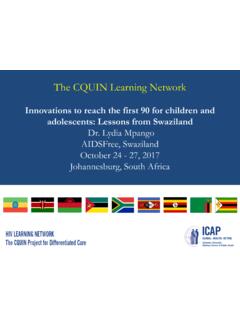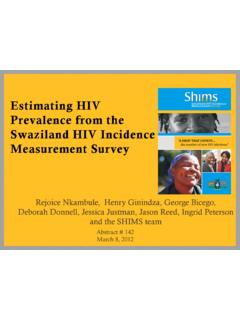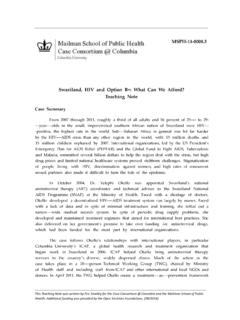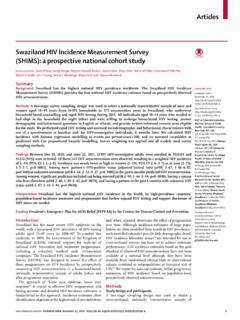Transcription of ENGAGING COMMUNITY LEADERS - Health Communication …
1 A TOOL FOR FACILITATING DIALOGUE ENGAGING COMMUNITY LEADERSTO PROVIDE A SAFE AND SUPPORTIVE ENVIRONMENTFOR ADOLESCENT GIRLS AND YOUNG WOMEN A Tool for Facilitating Dialogue 1 TABLE OF CONTENTSMODULE ONE: Gender and HIV 7 Introduction 8 Gender Terms and Definitions 9 What Do You Believe? 12 Gender Roles: Act Like a Man, Act Like a Woman 15 Powerful Choices 17 Experiencing a Power Imbalance 19 Conclusion 22 MODULE TWO: Adolescent Girls and Young Women s Vulnerability to HIV 23 Introduction 24 Lulu Dlamini s Story 26 Risks, Influences and Consequences of Sexual Relationships 30 Exploring the Causes of Adolescent Girls and Young Women s Vulnerability 32 Deciding Priorities 34 Developing an Action Plan 35 Conclusion 37 MODULE THREE.
2 Gender-based Violence 38 Introduction 39 Understanding Gender-Based Violence 40 Roots of Gender-Based Violence 42 Consequences of Gender-Based Violence for Adolescent Girls, Young Women and their Families 44 Consequences of Gender-Based Violence for the COMMUNITY 46 Supporting Each Other 48 Conclusion 50 MODULE FOUR: Stigma and Activism 51 Introduction 52 Stigma and Discrimination 53 Understanding Stigma 54 Causes and Effects of Stigma 58 Seeing Connections 59 Advocacy for Change 62 Change for the Future 65 Conclusion 66 ENGAGING COMMUNITY LEADERS to Provide a Safe and Supportive Environment for Adolescent Girls and Young Women 2 APPENDICES 67 Appendix I: Powerful Choices Worksheet 68 Appendix II: Lulu s Story 69 Appendix III: Action Plan 71 Appendix IV.
3 Close Connections Character Statements 73 Appendix V: Review of HIV Facts 74A Tool for Facilitating Dialogue 3 LIST OF ACRONYMSARV AntiretroviralART Antiretroviral TherapyAIDS Acquired Immunodeficiency SyndromeAGYW Adolescent Girls and Young WomenCCP Johns Hopkins Center for Communication ProgramsCEF COMMUNITY Engagement FacilitatoreNSF Extended National Multisectoral Strategic Framework for HIV and AIDS 2014 2018 GBV Gender-based
4 ViolenceHC3 Health Communication Capacity CollaborativeHIV Human Immunodeficiency VirusMICS Multiple Indicator Cluster SurveyMTA D Ministry of Tinkhundla Administration and DevelopmentNERCHA National Emergency Response Council for HIV and AIDS PLHIV People Living with HIVPMTCT Prevention of Mother-to-Child Transmission of HIVSTI Sexually Transmitted InfectionSHIMS swaziland HIV incidence measurement SurveySNAP swaziland National AIDS ProgramSWANNEPHA swaziland National Network of People Living with HIV and AIDSSWAGAA swaziland Action Group Against AbuseUSAID United States Agency for International DevelopmentVMMC Voluntary Medical Male Circumcision ENGAGING COMMUNITY LEADERS to Provide a Safe and Supportive Environment for Adolescent Girls and Young Women 4 ACKNOWLEDGEMENTS AND THANKSWe are immensely grateful to COMMUNITY LEADERS .
5 The Health Communication Capacity Collaborative (HC3) staff at all levels and our collaborating partners notably the National Emergency Response Council for HIV and AIDS (NERCHA) and the Ministry of Tinkhundla Administration and Development (MTAD) for investing their time and providing invaluable insights during regional meetings and various interactions, all of which have informed the development of this it is not possible to acknowledge each individual and organization that contributed to the development of this tool, the core team included Glory Mkandawire, Bheki Vilane and HC3's COMMUNITY Engagement Team.
6 The team was greatly inspired by the technical support of Beth Mallalieu, who worked tirelessly to provide invaluable strategic information, and by the guidance of Lynn Van Lith during her visit to swaziland in October 2015. Several existing manuals were adapted to create this tool. We thank the organizations that created the manuals and evaluated their effectiveness. These manuals include SASA! by Raising Voices; Go Communities! and the African Transformation Facilitators Guide by Johns Hopkins Center for Communication Programs (CCP); Rethinking Domestic Violence: A Training Process for COMMUNITY Activists by Raising Voices; and Stepping Stones by Alice Welbourn.
7 Activities from the Interagency Gender Working Group were also , this tool was made possible by the generous support of the American people through the United States Agency for International Development (USAID); however, the contents of this tool are the responsibility of HC3 and do not reflect the views of USAID or the United States Tool for Facilitating Dialogue 5 INTRODUCTIONW elcome to ENGAGING COMMUNITY LEADERS to Provide a Safe and Supportive Environment for Adolescent Girls and Young Women A Tool for Facilitating Dialogue.
8 This tool is aimed at ENGAGING COMMUNITY LEADERS to reduce vulnerabilities and increase the safety of adolescent girls and young women (AGYW) in swaziland 's HIV response. The goal of the extended National Multisectoral Strategic Framework for HIV and AIDS 2014 2018 (eNSF) is to halt the spread of HIV and reverse its impact on Swazi society. The first priority, in pursuit of that goal, is to prevent new HIV infections and reduce mortality among people living with HIV (PLHIV). A series of studies and surveys revealed that gender inequality is a key factor influencing the spread of HIV in swaziland .
9 In patriarchal Swazi society, cultural values and norms uphold men s privileges and tend to constrain women s decision-making regarding sexual and reproductive Health . Gender inequality is prevalent in sociocultural, economic and political areas of Swazi society. It is characterised by risk taking, including ENGAGING in early sexual behaviour, and reluctance to seek Health care. According to the swaziland Multiple Indicator Cluster Survey (MICS; 2010), percent of young women and percent of young men reported having sex before the age of 15.
10 Intergenerational sex defined as young women having sex with men 10 or more years older than themselves also increases the risk of HIV transmission among young women. In swaziland , 14 percent of AGYW reported being in intergenerational relationships ( swaziland HIV incidence measurement Survey [SHIMS], 2014). Gender-based violence (GBV), including sexual abuse, remains a daunting challenge for swaziland in its response to HIV and AIDS. GBV limits the ability of the abused person to negotiate safer sexual acts and often interferes with adhering to treatment.










